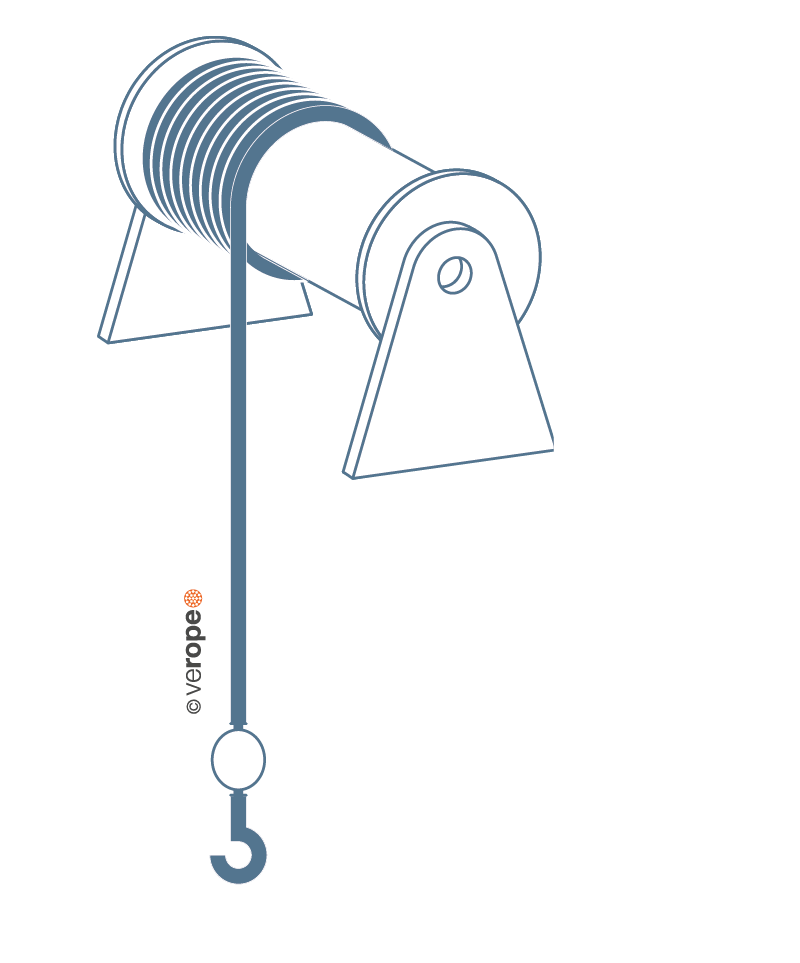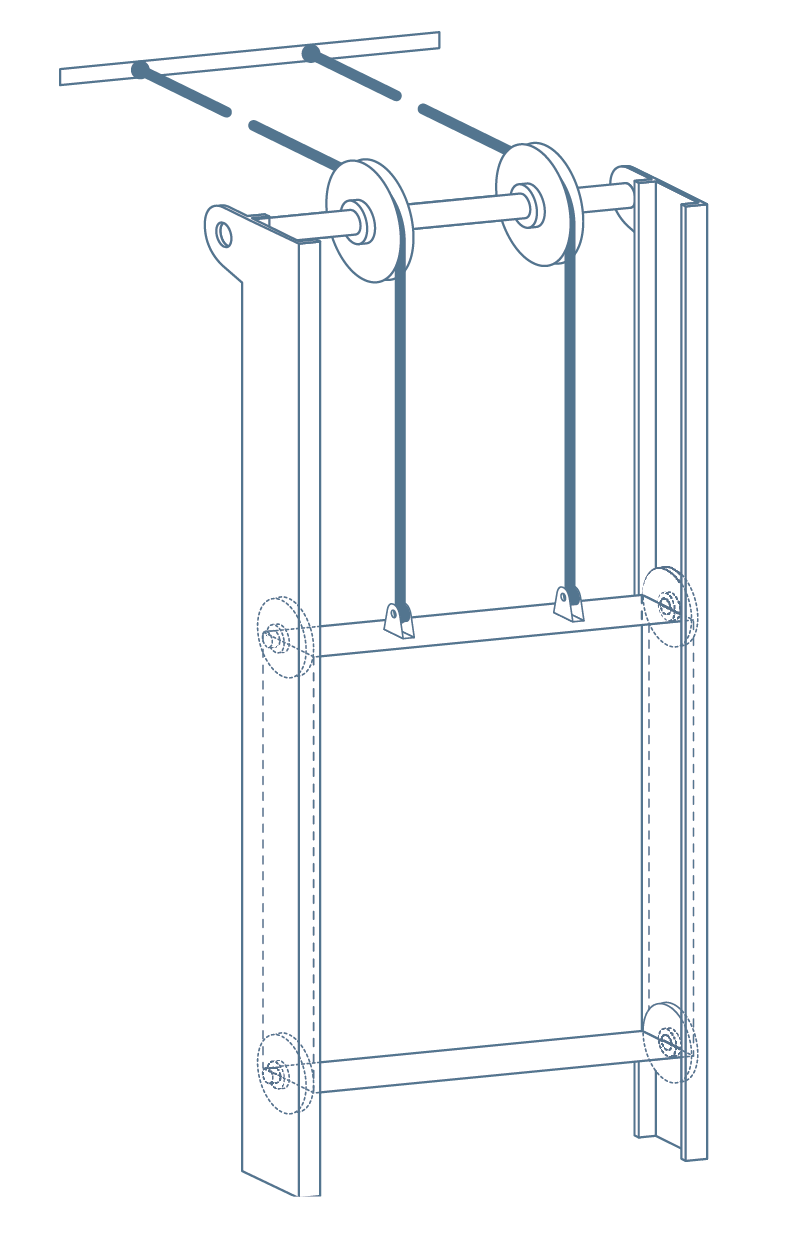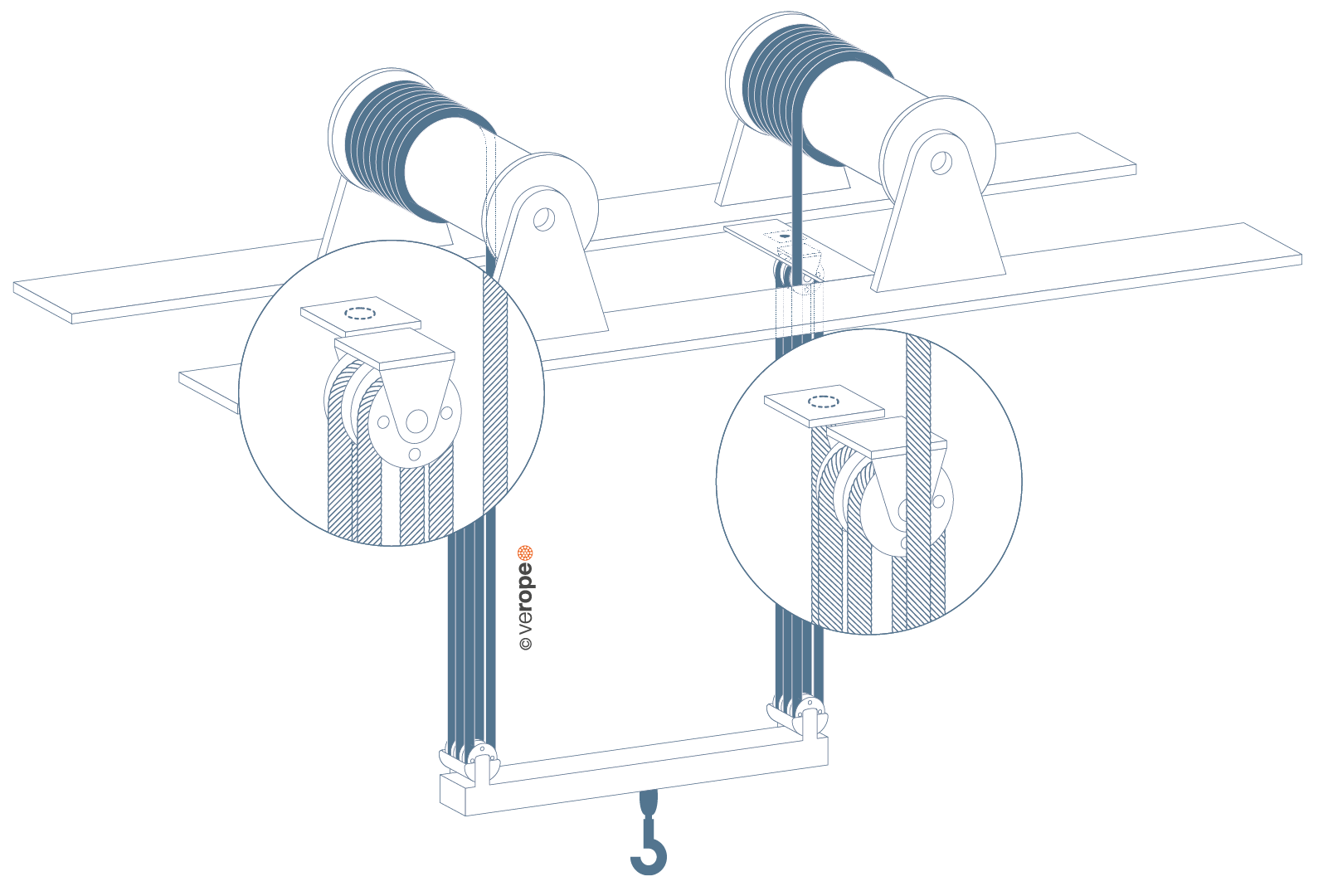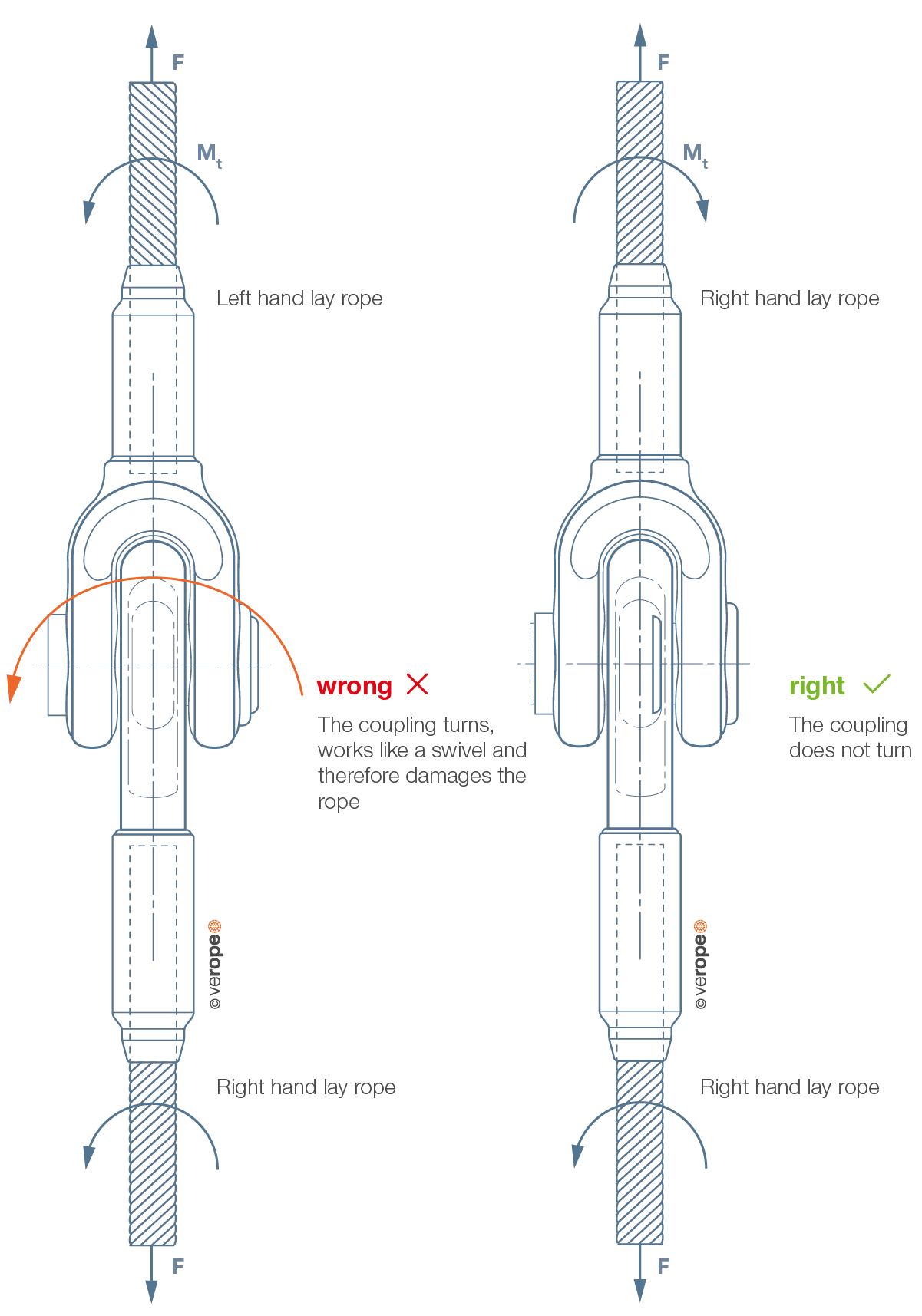Rope Technology
Choose the right
rope for your
application
Choose the right
rope for your
application
Two views have to be matched to select the right rope: the application and the rope point of view! The “universal rope” that is suitable for all applications does not exist. Therefore there are a variety of different rope constructions that best meet the requirements for a given duty. With the following remarks we want to give some practical information to help choosing the right crane rope depending on the application. Needless to say that whenever you are in doubt the verope team is happy to assist.
Application view
The main purpose of a crane is without any doubt to hoist something from place/level A to B, for which you need a Hoist rope.
Besides the crucial “Hoist application” a wide variety of other functions, depending on the crane type itself, is needed to operate a crane, e.g
- Luffing ropes to position the boom
- Trolley ropes to move the load on tower cranes or container cranes
- Pendant ropes to hold the boom or other crane structures
- Installation ropes to mount or dismantle the crane
- …and others

Rope view
From the technical point of view there are two main categories, crane ropes can be divided into, when focusing on the rope application in cranes:
- rotation-resistant ropes – Sometimes colloquially also named as non-rotating ropes or multi-strand ropes
- Non-rotation resistant ropes
➜ “Hoist Application”
As a basic guidance the following rule has proved one´s worth: For all “Hoist applications”, either main or auxiliary hoists, rotation-resistant Ropes are used exclusively, when:
- the load is unguided (figure 75) and/or
- high lifting heights are required
Only rotation-resistant ropes provide load stability so the load has no or little tendency to rotate. Rotation-resistant ropes that are fixed to the crane construction transmit no or little torque to the attachment point. Therefore rotation-resistant verope special wire ropes guarantee safe operation. Ropes that are defined as rotation-resistant according to the specified standards vary regarding their resistance to rotation depending on the construction type.
To show the difference regarding resistance to rotation different “classes” are formed.. For example EN 12385-4 nominates the rope class “35×7”, which describes rotation-resistant ropes having three layers of strands and the rope class “18×7” which describes rotation-resistant ropes having only two layers of strands. The rotation resistance of both classes, as well as the production cost clearly differ and herewith the prices will also vary .
In addition, as a further example, the ASTM A 1023 describes three rope categories, categorized by their resistance to rotation. Please find the two categories “1” and “2” that are widely used as hoist ropes in cranes:
- Category 1-rotation-resistant ropes have at least 15 outer strands and provide best resistance to rotation
- Category 2-rotation-resistant ropes have 10 or more outer strands
As general guidance rotation-resistant ropes considered being “35×7”-class ropes provide comparable resistance to rotation as category 1-ropes according to ASTM A1023 whereas rotation-resistant ropes considered being “18×7”-class ropes provide comparable resistance to rotation as category 2-ropes according to ASTM A1023. For demanding applications category1-rotation-resistant ropes have to be used.
Please Note: Ropes of the class “35×7″/category1 have to be replaced always by ropes of the same/comparable class and never by ropes of class “18×7″/category2. Whereas ropes of the class “18×7″/category2 can be replaced also by ropes of category1/”35×7” from a technical point of view.
Information: In addition to rotation-resistant ropes, which are manufactured according to national or international standards, there are many rotation-resistant ropes designed and manufactured “besides” the standard to meet even higher demands. These are real Special Wire Ropes, developed for highest demands regarding rotation resistance, for example highest lifting heights of modern cranes. To give customers general guidance about such special ropes the above mentioned standards are used as a reference to classify special ropes because the fundamental properties are comparable, although the performance is better.
Important: When rotation-resistant ropes are required, they must never be replaced by non-rotation-resistant ropes.
➜ Usage of a swivel on hoist ropes
The usage of a swivel can be helpful to eliminate twist generated under certain circumstances within the rope drive, e.g. if fleet angles between the drum and the first sheave or between the sheaves are in some configurations above recommended limits. In multi-reeving applications the swivel can’t compensate twist in all falls but the first falls from the swivel. The swivel reduces the risk of either hook cabling or rope damages like waviness or basket deformation that can lead to rope discard.
Please note that ropes considered being “35×7”-class ropes/category 1-ropes according to ASTM A1023 could be used with or without a swivel.
EN 12385-3 and ISO 21669 give further information regarding the swivel usage.
verope’s® product range of rotation-resistant ropes
verope’s product range of rotation-resistant ropes contains the high-performance products that are part of the “-top”-series:
- verotop P
- verotop XP
- verotop
- verotop S
- verotop E
- and the 4-strand rope construction
- vero 4
With the exception of the 4-strand rope vero4 all our ropes are high performance category-1 rotation-resistant ropes, providing best resistance to rotation. All “top”-series crane ropes can be used either with or without a swivel.
The vero4-product, a very robust rope, is designed for harshest working conditions with dynamic impact loads. Although the vero4 rope is part of the rotation-resistant group the vero4-product may not be used with a swivel.
The basic rule for “Hoist application” is to use rotation-resistant ropes.
Following that rule you can’t fail but as with all rules there are exceptions under certain circumstances:
1. For “Hoist application” and guided loads non-rotation resistant ropes can be used too because the torque generated under load is held by the frame, guiding the load (figure 76).
2. For “Hoist application” and unguided loads non-rotation resistant ropes can be used too, when the same rope construction ropes are used as a pair that consists of right and left hand ropes (figure 77).
The second configuration also provides rotational stability so the load has no or little tendency to rotate because the amount of torque generated under load is equal but in opposite directions: the result – torque equilibrium.
Important: Rotation-resistant ropes are clearly inferior regarding the bending cycle performance in comparison to non-rotation-resistant ropes. Therefore non-rotation-resistant ropes should only be replaced by rotation-resistant ropes under utmost care and after consulting with rope experts.


➜ More crane applications
Non-rotation resistant ropes usually achieve more bending cycles than rotation-resistant ropes or semi-rotation resistant ropes. However, they exert a torque on the end fitting when under load.
Therefore non-rotation resistant ropes can only be used, if the ends of the ropes are permanently protected against twisting.
Non-rotation resistant ropes are always the right choice, when the characteristic “rotation-resistance”, which only rotation-resistant ropes offer, is not required. This is the case for many rope applications, e.g. for luffing ropes, trolley ropes, pendant ropes or installation.
Note: With coupling of non-rotation resistant ropes, e.g. pendant ropes or grab ropes, only identical ropes of the same construction, meaning: the same diameter, the same lay type and lay direction have to be used (figure 78). Combining ropes with different lay directions would turn up the ropes and thus destroy them.

Application of regular (or ordinary) and Lang’s Lay ropes
The choice of the lay type must consider the specific use of the rope, the rope construction, crane components and the expected wear factors in use, which determine the lifetime of the rope substantially.
The aim of the rope choice is a high rope lifetime ensuring a high safety factor at the same time, which means the operator can recognize the secure operating condition of the rope reliably at any time, considering the discard criteria of the specific application. Therefore a general statement about the use of regular or lang’s lay ropes is not possible or not useful without knowledge of the specific case/application.
➜ Ordinary (regular) lay ropes
Ordinary lay ropes are widespread which are therefore presumably considered as universally applicable. Ordinary lay ropes have a very good structural stability due to the opposing stranding of the wires and strands which make them more resistant against external twist. The rope torque is lower than the one of lang’s lay ropes. Ordinary lay ropes also offer a good wear-resistance. Construction wise the externally visible wire breaks appear earlier of ordinary ropes than of lang’s lay ropes due to the higher pressure between wire and rope groove and a stronger wire bend within the strand, which makes it easier to recognize wire breaks and thus the rope state, making it easier to evaluate the discard criteria. Ordinary lay ropes are still no universal ropes for all applications under the abovementioned aims of the rope choice.
➜ Lang’s lay ropes
Lang’s lay ropes are more demanding not only in the production process, but also with the application, beginning with the installation. The reason for this lies in the stranding of wires and strands in the same direction, which raises the rope torque and makes lang’s lay ropes substantially more sensitively against every kind of external twist.
Lang’s lay ropes reach very high bending cycles until break because of the geometrically more favorable contact conditions between wire and rope groove which leads to the reduction of the pressure in the contact areas. This reduction of pressure is advantageous to the lifetime of the crane components and the rope itself.
However, it must also to be mentioned that in comparison to ordinary lay ropes the development of the externally visible wire breaks occurs more slowly. Therefore the recognition of the discard criteria due to externally visible wire breaks can be complvicated. For this reason the numbers of wire breaks until discard are clearly lower for lang’s lay ropes than for ordinary ropes with identical rope construction. Therefore also lang’s lay ropes are no universal ropes for all application under the abovementioned criteria of rope choice.
Important: As described in the “Lang’s Lay ropes” paragraph, these ropes can have an increased amount of internal wire breaks, which are not visible on the outside. This is expecially the case with rotation-resistant ropes in Lang Lay under bending cycle usage. This should always be clarified with a rope expert.
➜ Crane components and crane geometry
Besides the rope itself crane components and crane geometry are important criteria for the right rope choice. The applied drum system and the crane geometry constructively selected fleet angles are to mentioned particularly.
While on single-layer drums the rope gets stressed due to tensile load and substantially due to bend and lateral deflection and thus twists, dominates on multi-layer drums mechanical wear and lateral pressure stress between the touching ropes.
The crane geometry constructively selected fleet angle is a very important characteristic for a reliable rope spooling and the degree of rope wear. For multi-layer spooling a maximum fleet angle of 1,5° is recommended, while single-layer drums can work with higher fleet angels like for example up to 4°.
Consequently the right rope choice is to be matched with these operating-/wear conditions.
The following basic rules for the correct choice of rope lay types for ropes that spool on drums have proved themselves and therefore are also recommended by us:
- single-layer drums = ordinary lay ropes
- multi-layer drums = lang’s lay ropes
On single-layer drums the ordinary lay ropes have clear advantages, because it can usually compensate the bigger fleet angle. Also the easier recognition of externally visible wire breaks is an important argument for the use of ordinary lay ropes on single-layer drums where strong mechanical rope wear, which also leads to wire breaks, does not or not substantially exist.
On multi-layer drums the bending fatigue resistance of the rope is not decisive for the rope lifetime but its resistance to mechanical impact is. Ordinary lay ropes are less suitable for multi-layer drum spooling because the wires of the neighboring ropes can rub with each other. This leads to high mechanical wear. The touch of the neighboring ropes during the spooling process is also well “audible”. The results are premature wire breaks. Lang’s lay ropes have proved themselves in the multi-layer spooling because neighboring ropes can not rub into each other, which raises the lifetime of the rope significantly.
The use of ropes with compacted outer strands and/or rotary swaged rope constructions can
clearly raise the rope lifetime due to the very smooth surface and the high resistance to abrasion.
The abovementioned statements have proved themselves in practice. Customer desired, occasionally divergences should therefore be analyzed thoroughly with regard to:
- specific operating conditions of the rope
- the chosen rope construction
- the customer-sided rope supervision concerning discard criteria before a divergent decision can be made